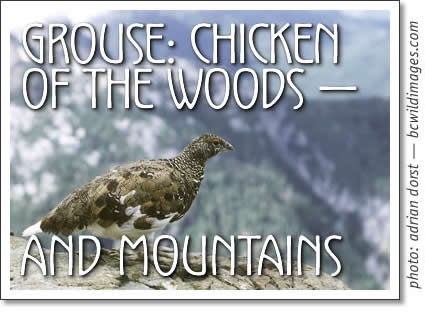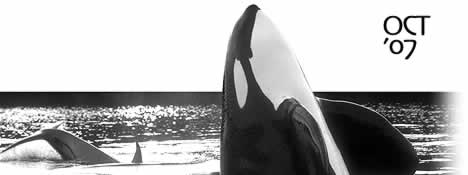
Grouse - Chicken of the woods and mountains
by Adrian Dorst, Tofino

Most of you have probably seen one on occasion, crouched on the shoulder of the road, as you go whizzing by at 100 clicks--a bird that resembles a chicken, both in profile and in its ground-foraging habits. Where it differs markedly from the barnyard variety is in its tail, which it can spread into a fan. What you saw is known as a grouse, a bird well adapted to foraging on the forest floor, where it uses its forward-pointing toes to scratch the earth, much as a chicken does, and to which it is, in fact, distantly related. We have three species on Vancouver Island and all three occur sparingly in Clayoquot Sound.The one we are most likely to encounter locally is the Ruffed Grouse. This bird is found in forest habitat across most of North America. In size it is similar to a banty rooster. It has a black ruff around its neck which it can inflate, a small crest on its head which it can raise, and a tail which it can spread into a broad fan. The colour of it plumage, broadly speaking, can be described as being various shades of brown, flecked with white and black. In short, a very handsome bird.
In spring, in order to attract a female, the male stands on top of a log and beats his wings so vigorously, he creates a thumping sound that reverberates through the woods--a behaviour much like that of adolescent males of the human species who these days drive around with boom boxes at a volume loud enough to cause brain damage. As the wings wind up, the sound speeds up, much as a ping-pong ball does on a table. When a female comes near, the male inflates his black ruff and spreads his tail to the max. Whoa Nellie! If that doesn't impress her, nothing will.
Ruffed Grouse spend most of their time on the ground or sitting in trees and usually fly only a short distance. In fact their bodies are designed for very rapid takeoff, not prolonged flight. In areas where they are hunted, birds become shy and reclusive, and when flushed, launch themselves into space like a rocket, zig-zagging among the trees before disappearing. This practice has made them prized as a game bird over much of the continent. Because they fly for only a few hundred yards at a time, the hunter may well encounter the bird again a short time later.
Never common locally, Ruffed Grouse appear to have declined since the 70s. The best habitat for the species was usurped when the Long Beach Golf Course was built. Still, you can find an occasional individual along the shoulder of Grice Bay Road, and last summer I was surprised to see a family of birds on Vargas Island, where I had never seen them before. Father Charles Channel is apparently not an insurmountable obstacle for this short-distance flyer.
Another grouse found locally is the Sooty Grouse, formerly known as the Blue Grouse. Ornithologists had known for many decades that the variety found on the coast is somewhat different in appearance from the one in the interior. However, only recently did studies reveal that the two varieties were sufficiently different to split them into two distinct species. The name derives from the colour of the male, which is a sooty slate-blue. Females are mottled brown. This species, with a weight of more than a kilo is nearly twice the weight of a Ruffed Grouse.
Because Sooty Grouse prefer semi-open woodlands, habitat on the coastal plain is marginal at best. They may be found in clear-cuts before the new trees reach significant height, and occasionally in coastal bogs. I have also found individuals on the summit of Radar Hill and once on Lone Cone. As with the previous species, the Sooty Grouse has become very hard to find locally. More favourable habitat is to be found further inland such as in the Taylor River Valley where logging and fires have created more open country. The best time to find one is in spring, when the males emit loud whoomping sounds in order to attract a mate and announce their territory to other males. By imitating the call you may be able to attract a male within range. I once had a bird fly in and land at my feet, then proceed to vigorously tug my pant leg with its bill. It was determined to defend its territory no matter how big the intruder.
In contrast to most other bird species, which in late summer or fall either leave for southern climes or move to lower elevation, Sooty Grouse do the opposite and move higher up the mountain slopes to the sub alpine, where they spend the winter feeding on conifer needles.
The third grouse in our area belongs to a group called ptarmigan that have adapted to life in the harsh northern environment and on mountain tops by having feathered feet to protect them from the cold and by turning pure white in winter in order to avoid being seen by predators. There are three species in Canada--Willow, Rock and White-tailed Ptarmigan. Unlike the first two, White-tailed Ptarmigan are not found in the arctic tundra at all, but only in the western mountains where they spend the summer at high elevation. By spring, they begin to lose their snow-white dress and adopt a plumage of browns and greys that allow them to camouflage themselves perfectly against the rock. So confident are these birds of their ability to "disappear", I once held a camera 12 or 15 inches away from one as it crouched on a rock. Though somewhat nervous of my presence, it nevertheless stayed put.
Because White-tailed Ptarmigan inhabit remote alpine areas of Vancouver Island, little was known of their distribution or their abundance. In 1995, a survey was begun by ubc to determine how widespread the species was on the island. This was done by seeking information from hikers and mountaineers. It turned out that the birds were more widespread than previously believed. However, because of the warmer summers of recent years and the decreasing snow pack, that information is probably already outdated. When I first encountered the species on the summit of the Mackenzie Range, high above Highway 4, in August of 1974, there were areas of snow 15 to 20 feet deep. By the mid to late 80s, that snow pack was gone by early July.
I have encountered this species on only one other occasion in our area, and that was on the Clayoquot Plateau in August of 1987, when fellow mountaineer, Michael Poole, discovered one by hearing "the clacking of its feet on the rocks" and called me over. There is more favourable habitat at this location and the snow lasts longer into the season than on the Mackenzie Range, so hopefully some birds still persist there. The birds on Vancouver Island, by the way, have been isolated long enough from their mainland cousins to be considered a separate sub-species.
Unless you are a mountain hiker, you may not see a ptarmigan anytime soon, but in places like Sharp Road, Grice Bay Road and around the airport, a Ruffed Grouse may reward you with a rare glimpse.
Adrian Dorst offers guided bird walks and guided nature hikes in the Meares Island rainforest. Call him at (250) 725-1243 or email adorst@island.net.
tofino | tofino time | activities | accommodation | events | directory
maps | travel | food | art & artists | photos | horoscope | tides
search | magazine | issues | articles | advertising | contact us
hosted in tofino by tofino.net & studio tofino
© 2002-2014 copyright Tofino Time Magazine in Tofino Canada
Tofino birdwatching article on Ruffed Grouse, Sooty Grouse and White-tailed Ptarmigan on Vancouver Island. Written by Tofino birding expert Adrian Dorst for Tofino Time Magazine.
